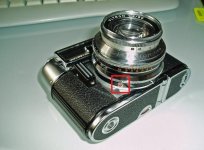BW400CN
Bessamatic forever!
One last question, my III CS has a Prontor 500 SLK-Y shutter on the Ultron lens. It has a handle with a red dot on the lower left side when looking from the front side of the camera. I guess this may be the self-timer? I have seen a self-timer referenced in a Vitomatic IIa manual, also operated from the shutter, but the shutter on the IIa is different from the Prontor on the III CS. What is the function of the handle and how to operate it?
I don't know the Vitomatic that well - so can you please post a pic of it?
It can be the selftimer or (I´m ain´t sure if the vitomatic has had this) the flashsynchro when it is labed with X+M like the Bessamatic had (bulb and electronic flash mode)


